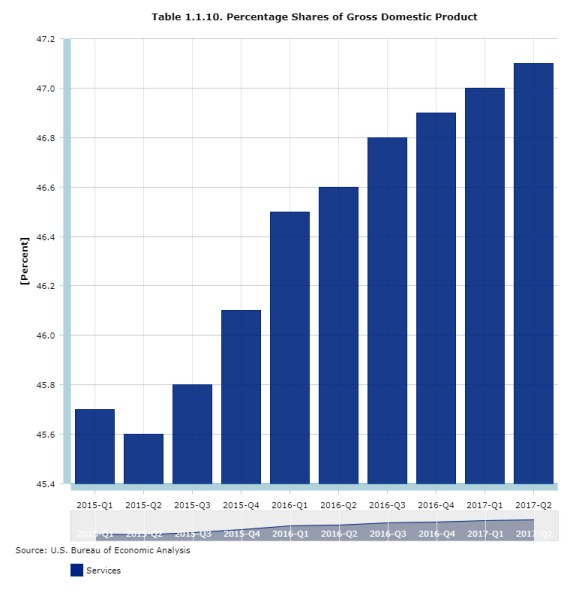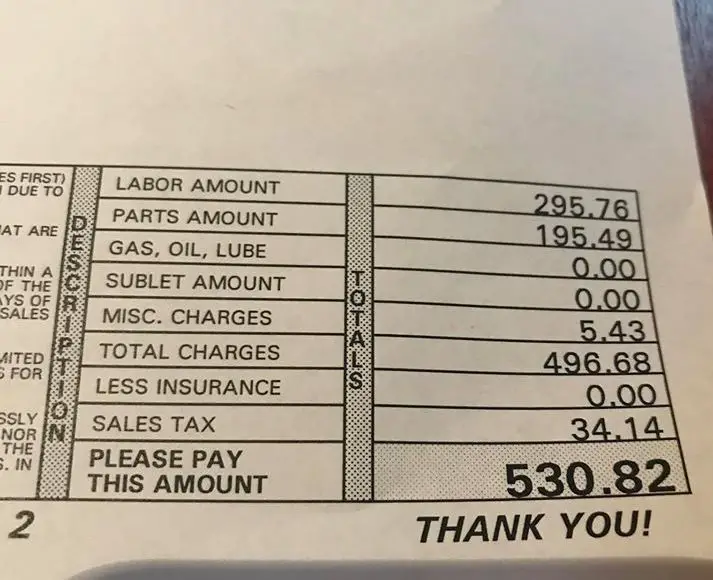This post is part of a series on Economics in the automotive industry.
When someone thinks of Gross Domestic Product or the total value of goods and services produced in a country during a single year, one usually thinks of tangible goods such as natural resources like steel and wood or products you can touch like cars and computers. While tangible durable and non-durable goods are a part of personal consumption expenditures and GDP at large, so are intangible goods like services.
Services, as a slice of the entire GDP pie, makes up the largest slice of the United States GDP. According to the Bureau of Economic Analysis, the GDP of the United States right now hovers around $19 trillion. Services alone makes up 47 percent of that $19 trillion or about $9 trillion. You’ll find that most developed countries have services as a percentage as large as if not larger than the United States.

Common service industries include such juggernauts like entertainment (think Hollywood), government, telecommunications, the entire tourism industry, real estate, banking, and education (the cost per unit to take a College course.) The intangible goods produced by these industries cannot be touched. You can’t hold a phone call nor can you carry a surgery in a container. It is a service and is priced accordingly to what the rate for that service is.
Automotive repairs are definitely part of the service industry. While a car is a durable good, diagnosing and repairing a car is part of the service industry. Like any service industry where expertise is required, experts will charge a rate. When you’re repairing your car, that’s often broken up into a diagnostic rate, labor rate, and cost for parts. Sometimes dealerships won’t charge a flat diagnostic rate and roll that into the labor fee.
A good service department will make the customer understand what exactly they’re being charged for, what the total will roughly be, a promise to phone the customer to authorize additional work as needed, and then to go over the work with the customer to assuage them of any questions and concerns they might have about the repair.
Oftentimes, the horror stories come from service departments who listen to what the customer wants, provide a “copy and paste” spiel about what they expect to charge and point the papers to the customer to sign off on the work so their “ass is covered” so to speak. The customer leaves their car for repairs with a vague idea of what’s going to happen and might sub-consciously not be aware of what they just signed off on. When they get their bill and car returned repaired, they’re shocked and appalled at what they have to pay and leave with a bad taste in their mouth. They weren’t given the time of day to understand the value of the service they just received.
That brings us to the case study attached to services and intangible goods that I came across on a local car forum on Facebook. The customer dropped off his car at a dealership for repairs, a service. He mentioned to the service manager that his horn doesn’t work and he’d like to get someone to look at why his wiper fluid doesn’t spray and why his AC fan only blows on the highest speed settings and not on the lower speed settings. I don’t have the whole story but I can only presume he had a vague idea of the labor rate (which was at $98/hour) and the replacement horn price amongst a few other parts ($195.)

His total bill was $530 pictured above. It was so much he decided to complain about his experience on the aforementioned car forum whereupon he received a ton of comments explaining to him why they charged him as much as they did.
To the average middle-class American, although a $530 bill isn’t going to put you into the poor house, it’s still a sizeable chunk of money. To a college student or younger car enthusiast, that could be two weeks pay. $530 could be a lot or a little. In this case, it was a lot.
So what did he pay for? He paid for the tangible parts, but he also paid for the intangible service of an experienced technician (at the rate of $99 hour.) That person probably had to go to tech school for two years, go through 2-5 years of on the job training, had to invest thousands of dollars in tools/diagnostic equipment and earned his SAE certification amongst other certifications to stay up to date on the specific cars he works on. He is a specialist and his time is valuable.
Admittedly, the person who was complaining about his dealership experience for his repairs also admitted that he thought his fan problem was just a fuse and not the blower motor resistor they found to be the problem.
Included in what he paid for was the convenience of not having to wrongly diagnose his fan issue, throwing all sorts of his own time and parts at the issue. He might’ve paid for a weekend of self-diagnosing his issues, going in circles.
Presumably, he left the dealership with a stiff upper lip, not admitting his disappointment and not understanding what he just swiped his card for. The dealership should always assume that the customer would appreciate a bit of education on their repairs and gone through with him what happened to his vehicle.
Realistically, people just want to get on with their day and only in an ideal world or the Ritz Carlton would this type of service be rendered time and time again. I mean, there’s a reason why service department dealerships are called stealerships and get a bad rep in the first place.
So when you go to a dealership for service, understand you are paying for a mechanics time. You’re paying for his expertise, the convenience of not having to do it yourself and it’s something that’ll cost you.




